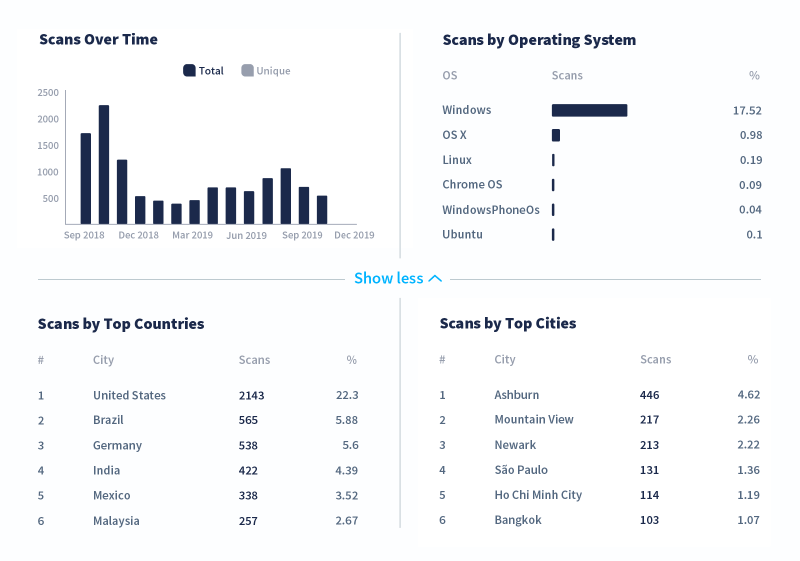- Best Practices ●
- COVID-19 ●
- Industry Trends ●
- Partners ●
- Product ●
Sales-Driving Ways To Use QR Codes in Your B2B Marketing Strategy
The B2B landscape is evolving—B2B buyers are now conducting research before contacting sales teams, and marketers are working with resource constraints.
Unfortunately, this means that B2B marketers can’t continue with traditional marketing tactics. They must now create content that resonates with B2B buyers to guide them through the sales funnel and identify the most impactful marketing tools and strategies to optimize resource allocation.
While it may seem like a lot to handle, it’s manageable when you have the right tools—like Quick Response (QR) Codes.
QR Codes make it easier for B2B buyers to access information—all it takes is a smartphone camera—and give marketers a view of how these buyers interact with their brands.
Below, we’ll explore some of the top ways to use QR Codes for business marketing.
-
Table of contents
- 1. Make more personal connections with better networking
- 2. Guide your audience from top to bottom of the funnel
- 3. Measure the impact of campaign efforts (and make adjustments as you go)
- 4. Establish a clear brand identity through customization
- 5. Transform physical assets into digital gateways
- A robust QR Code generator makes it easy to scale success
*Note: All brands and examples discussed below were found during our online research for this article.
1. Make more personal connections with better networking
Did you know that 40% of B2B prospects become customers through in-person events? If you’re not already taking advantage of them, you’re missing out on a potential goldmine for your business.
To make connections and drive sales during these events, you’ll need business cards. Yes, you read that right—while they may appear outdated compared to digital alternatives like LinkedIn profiles, business cards are a tangible representation of your business and lend credibility and professionalism to your brand. So it’d be a mistake to go to these events without them.
Nonetheless, printed business cards have some limitations: They are extremely limited in space, are easy to lose, and their standard formatting can get lost in the crowd.
The perfect solution to these limitations is a vCard Plus QR Code, otherwise known as a digital business card. It blends the best of both worlds, allowing you to maintain the physical touch of a standard business card and the limitless nature of digital alternatives.
This code streamlines the process of saving contacts—prospects just need to scan it to add your contact information to their mobile devices—and allows you to share much more information. You get to share everything from your phone number and email address to your social media profiles and office directions, giving potential customers all the details they need to reach out.
To enhance your likelihood of success with QR Codes on business cards, customize them to align with your brand image—use your brand colors and add your logo to make them recognizable. Also, ensure proper QR Code sizing for easy scannability—the minimum QR Code size should be 2 x 2 cm.
2. Guide your audience from top to bottom of the funnel
If you’re new to QR Codes, it’s common to be skeptical about their effectiveness in marketing. However, a quick look at their adoption rate will show you exactly how willing audiences are to use them—over 75 million people in the U.S. alone scanned a QR Code in 2021.
They can be the perfect tools for moving B2B buyers down the sales funnel, not only because of their ease of use but also because they allow you to do more with less. Whether you want prospects to see your product or service in action through a video or need a seamless way to direct them to your website for in-depth information on what you offer, a QR Code can be the perfect portal.
You can also use it to lead audiences to your social media profiles, event registration page (if you’re hosting one), product images, customer reviews, and more.
To elevate your digital marketing strategy with QR Codes, include them on all your physical marketing mediums—business cards, billboards, table tents, brochures, and the like—and ensure they direct your target audience to valuable content or product information.

3. Measure the impact of campaign efforts (and make adjustments as you go)
For any marketing campaign to achieve the best possible results, it’s important to experiment, track metrics, and optimize. QR Codes can help with all of that.
These nifty solutions come in two main types: Static and Dynamic QR Codes. The latter is trackable and provides analytics, making it a valuable addition to your marketing campaign—and by using analytics to assist in marketing decisions, you could save on your marketing budget.
Dynamic codes provide detailed tracking information: location by city and state, time scanned, operating device used, and total vs. unique scans, facilitating campaign comparisons across different periods and locations.
Combine this data with Google Analytics data (to follow a customer’s entire purchasing process), and you’ve got a recipe for marketing and sales success. You get to see the strategies that resonate the most with your audience and where many potential customers are located, helping you make well-informed campaign optimization and targeting decisions.

What’s more, you can edit Dynamic QR Codes. So, if you’ve accidentally made a mistake in your destination URL, want to update a link with a newer version, or even if you want to change the type of QR Code used (for example, use a video instead of images), you can do this at any time without changing the functionality of the existing QR Code. This saves time and costs for materials that would otherwise need to be reprinted.
4. Establish a clear brand identity through customization
Consistency is a key part of maintaining a successful business. Just look at a brand like IBM—it maintains a uniform image on everything from its marketing materials to its website and social media pages, making it instantly recognizable and reinforcing customers’ trust.
While maintaining consistency with some marketing solutions can be challenging, you don’t have to worry about this with QR Codes. They’re customizable and can reflect your brand identity.
Some QR Code design ideas you can implement for a clear brand identity include:
- Using brand colors to design the code.
- Incorporating your business logo into the code.
- Using your brand voice in the call to action (CTA).
Whether your QR Code is on social media, in an email campaign, or on products, you can match it to your brand’s style to add a touch of familiarity and increase audiences’ willingness to scan it.

5. Transform physical assets into digital gateways
Contrary to common belief, physical assets like print mediums are still effective in the modern business landscape. In fact, they have a higher brand recall (78%) than digital alternatives (30%). This is one of the reasons why marketing materials like brochures, pamphlets, and pop-up signage are common at conferences, speaking events, and trade shows—companies that want to create brand awareness use them to enhance memorability.
However, because of space limitations, print ads can’t communicate everything B2B brands want potential customers to know. That’s why many marketers are turning to—you guessed it—QR Codes.
By running print marketing campaigns with QR Codes, B2B marketers bridge the gap between offline and online mediums—they enjoy both the recall and tangibility of print materials and the limitlessness of the digital world.
A robust QR Code generator makes it easy to scale success
If you’ve decided to leverage QR Codes for business growth, you’re on the right track. The next step is to find a reliable QR Code generator.
There are many options available today, some free and others that require a subscription. While the free options undoubtedly save you money, they’re limited and generally inflexible: You can’t change the type of code or it’s destination once it’s generated, there are limited customization options, and you usually don’t have access to extensive analytics (if any at all, depending on the generator).
More robust generators often come with subscription plans with features that make their codes more versatile. Take QR Code Generator PRO, for example. While you can generate a few types of QR Codes for free, a premium plan gives you a lot more freedom, flexibility, and customization. You can great custom-branded codes featuring your logo and brand colors, design options like frames and corners, the ability to create codes in bulk, and insightful analytics. With QR Code Generator PRO’s Dynamic QR Codes, you’re free to change your destination URL, design, or code type at any time—all without affecting the functionality of your original code. This means you can monitor code performance throughout your campaign and edit them without needing to print new marketing materials.
Harness the power of QR Codes for B2B marketing with QR Code Generator PRO!
QR Codes are valuable assets for B2B marketing teams looking for efficient ways to share information with prospects and gain more insights into their target audiences. Besides allowing you to direct audiences to virtually any resource online, they provide scan data, which can help you gauge the effectiveness of your marketing strategies.
With QR Code Generator PRO, you can seamlessly create QR Codes for any purpose. Whether you want to direct customers to your web page, social media, image gallery, or vCard, we’ve got you covered. We also provide real-time tracking data, giving you a clear visual of QR Code scans throughout your campaigns.
Sign up for QR Code Generator PRO today to elevate your B2B marketing with reliable, scalable, and trackable custom QR Codes!






 Add custom colors, logos and frames.
Add custom colors, logos and frames.
